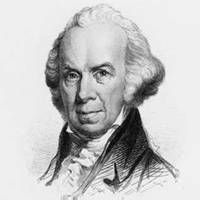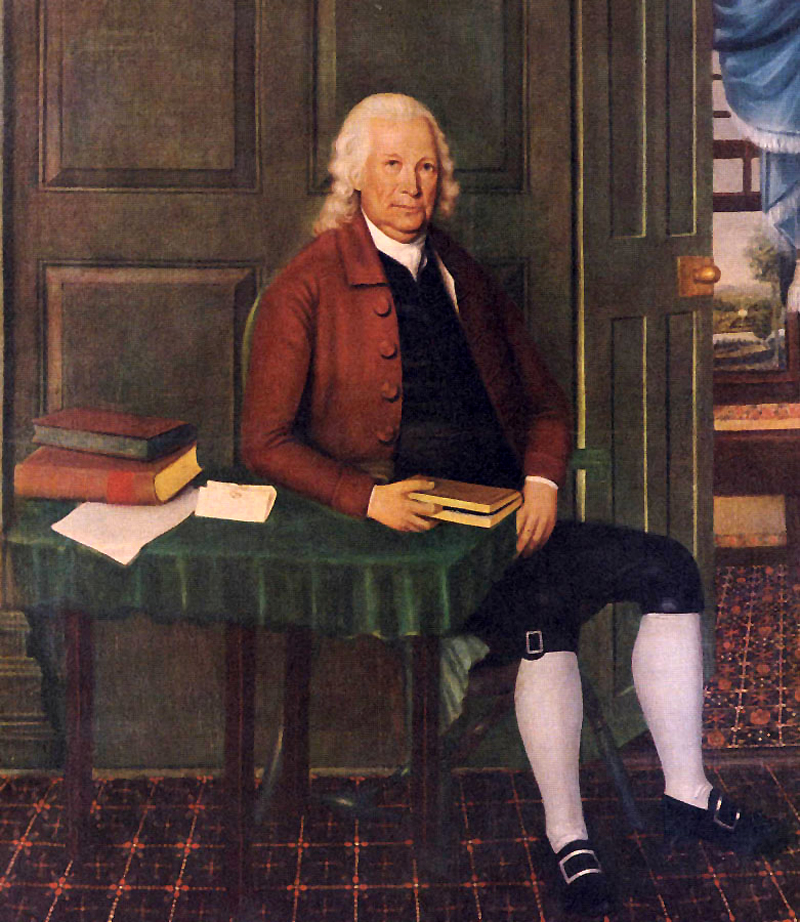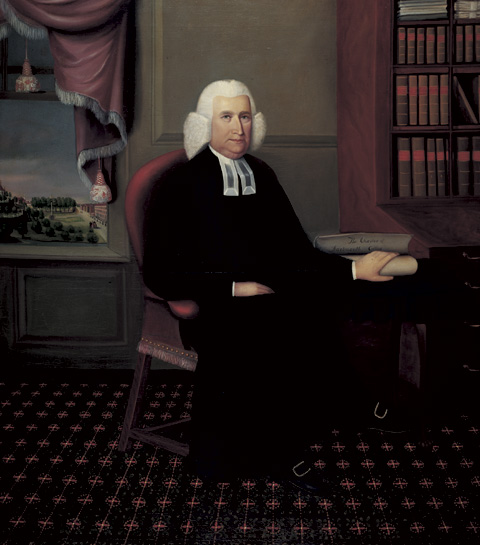|
John Taylor Gilman
John Taylor Gilman (December 19, 1753September 1, 1828) was a farmer, shipbuilder and statesman from Exeter, New Hampshire. He represented New Hampshire in the Continental Congress in 1782–1783 and was the fifth governor of New Hampshire for 14 years, from 1794 to 1805, and from 1813 to 1816. Early life Gilman was born in Exeter, in the Province of New Hampshire, the son of Ann (Taylor) and Nicholas Gilman. His brother was Nicholas Gilman, who had signed the U.S. Constitution. His family had settled in Exeter in its earliest days. He lived in the Ladd-Gilman House, now a part of the American Independence Museum. He received a limited education before he entered into the family shipbuilding and mercantile businesses. Aged 22, he read aloud a Dunlap Broadside brought to New Hampshire on July 16, 1776 to the city of Exeter. The American Independence Museum commemorates his brave act every year at their American Independence Festival, where a role-player reads the Declaration in it ... [...More Info...] [...Related Items...] OR: [Wikipedia] [Google] [Baidu] |
William Plumer
William Plumer (June 25, 1759December 22, 1850) was an American lawyer, Baptist lay preacher, and politician from Epping, New Hampshire. He is most notable for his service as a Federalist in the United States Senate (1802–1807), and the seventh governor of New Hampshire as a Democratic-Republican (1812–1813, 1816–1819). Early life Plumer was born in Newburyport, Province of Massachusetts Bay on June 25, 1759, the son of farmer and merchant Samuel Plumer and Mary (Dole) Plumer. His family moved to Epping, New Hampshire in 1768, and he was raised at his father's farm on Epping's Red Oak Hill. Plumer attended the Red Oak Hill School until he was 17. Frequent ill health left him unsuited for military service during the American Revolution or life as a farmer, and after a religious conversion experience in his late teens, Plumer was trained as a Baptist exhorter (a lay preacher). For several years he traveled throughout the state to deliver sermons to Baptist churches and reviv ... [...More Info...] [...Related Items...] OR: [Wikipedia] [Google] [Baidu] |
Minutemen
Minutemen were members of the organized New England colonial militia companies trained in weaponry, tactics, and military strategies during the American Revolutionary War. They were known for being ready at a minute's notice, hence the name. Minutemen provided a highly mobile, rapidly deployed force that enabled the colonies to respond immediately to military threats. They were an evolution from the prior colonial rapid-response units. The minutemen were among the first to fight in the American Revolution. Their teams constituted about a quarter of the entire militia. They were generally younger, more mobile, and provided with weapons and arms by the local governments. They were still part of the overall militia regimental organizations in the New England Colonies. The term has also been applied to various later United States civilian paramilitary forces. History In the colony of Massachusetts Bay, all able-bodied men between the ages of 16 and 60 were required to participa ... [...More Info...] [...Related Items...] OR: [Wikipedia] [Google] [Baidu] |
1797 New Hampshire Gubernatorial Election
{{NewHampshire-election-stub ...
The 1797 New Hampshire gubernatorial election took place on March 14, 1797. Incumbent Federalist Governor John Taylor Gilman won re-election to a fourth term. Results References Gubernatorial New Hampshire 1797 Events January–March * January 3 – The Treaty of Tripoli, a peace treaty between the United States and Ottoman Tripolitania, is signed at Algiers (''see also'' 1796). * January 7 – The parliament of the Cisalpine Re ... [...More Info...] [...Related Items...] OR: [Wikipedia] [Google] [Baidu] |
Governor Of New Hampshire
The governor of New Hampshire is the head of government of New Hampshire. The governor is elected during the biennial state general election in November of even-numbered years. New Hampshire is one of only two states, along with bordering Vermont, to hold gubernatorial elections every two years as opposed to every four. Currently, the state's 82nd governor is Republican Party (United States), Republican Chris Sununu, who has served since January 5, 2017. In New Hampshire, the governor has no term limit of any kind. Only two governors have served more than three terms since the 18th century (when the term was for only one year), John Lynch (New Hampshire governor), John Lynch, who won a fourth two-year term on November 2, 2010, and Chris Sununu, who won a fourth two-year term on November 8, 2022. John Taylor Gilman had been the last governor before Lynch to serve longer than six years, serving 14 one-year terms as governor between 1794 and 1816. Gilman is one of seven governors ... [...More Info...] [...Related Items...] OR: [Wikipedia] [Google] [Baidu] |
Federalist Party
The Federalist Party was a Conservatism in the United States, conservative political party which was the first political party in the United States. As such, under Alexander Hamilton, it dominated the national government from 1789 to 1801. Defeated by the Jeffersonian Republicans in 1800, it became a minority party while keeping its stronghold in New England and made a brief resurgence by opposing the War of 1812. It then collapsed with its last presidential candidate in 1816. Remnants lasted for a few years afterwards. The party appealed to businesses and to conservatives who favored banks, national over state government, manufacturing, an army and navy, and in world affairs preferred Kingdom of Great Britain, Great Britain and strongly opposed the French Revolution. The party favored centralization, Early federalism in the United States, federalism, Modernization theory, modernization, Industrialization in the United States, industrialization and Protectionism in the United S ... [...More Info...] [...Related Items...] OR: [Wikipedia] [Google] [Baidu] |
List Of New Hampshire Historical Markers (151–175)
This page is one of a series of pages that list New Hampshire historical markers. The text of each marker is provided within its entry. __NOTOC__ Markers 151 to 175 . Newington :Town of Newington "Boundary disputes among the early river settlers caused this area to be called Bloody Point. By 1640 Trickey's Ferry operated between Bloody Point and Hilton's Point in Dover. In 1712 the meeting-house was erected and the parish set off, named Newington for the English village, whose residents sent the bell for the meeting-house. About 1725 the parsonage was built near the town forest, considered one of the oldest in America." . Cherry Mountain Slide :Town of Jefferson "On July 10, 1885, at 6 a.m., a slide from Cherry Mountain's northern peak left a deep gash from Owl's Head to the Valley. A million tons of boulders, trees and mud loosed by a cloudburst rolled and tumbled a tortuous two miles, destroying Oscar Stanley's new home and his cattle, barn and crops. Farm hand Don Walker, ... [...More Info...] [...Related Items...] OR: [Wikipedia] [Google] [Baidu] |
Gilmanton, New Hampshire
Gilmanton is a town in Belknap County, New Hampshire, United States. The population was 3,945 at the 2020 census. Gilmanton includes the villages of Gilmanton Corners and Gilmanton Ironworks. The town became well known in the 1950s after it was rumored that the popular novel ''Peyton Place'', written by resident Grace Metalious, was based on the town. History Gilmanton was incorporated in 1727. First known as "Gilmantown", the town was home to the Gilman family, originally settled at Exeter. Twenty-four members of the Gilman family received land grants in the new town of Gilmanton. (Other families related to the Gilmans also received grants in the new town, including the Dudleys, the Leavitts, the Folsoms and the Coffins.) At one time it was the second-largest town in the state, following Portsmouth. The original town was larger than it is now, with villages and parishes including Belmont, Gunstock Parish ( Gilford), Hurricane, Tioga, Factory Village and Lakeport. A parish firs ... [...More Info...] [...Related Items...] OR: [Wikipedia] [Google] [Baidu] |
Nathaniel Folsom
Nathaniel Folsom (September 28, 1726 – May 26, 1790) was an American merchant and statesman. He was a delegate for New Hampshire in the Continental Congress in 1774 and 1777 to 1780, signing the Continental Association. He served as major general of the New Hampshire Militia during the American Revolutionary War. Private life Folsom was born into a large family in Exeter, New Hampshire. His ancestors were among Exeter's earliest settlers, having arrived with the Gilman family, to whom they were related, from Hingham, Massachusetts, where both families settled for a time before moving on to New Hampshire. The original spelling of the family name was Foulsham. The Folsoms continued to hold land outside Hingham, Norfolk, England, many years after leaving for the Massachusetts Bay Colony. In 1673, John Folsom of Exeter gave his son Peter of land in Norfolk County, England, which he had inherited from his family. Nathaniel Folsom's father Jonathan (c. 1685–1740) married Ann Ladd ... [...More Info...] [...Related Items...] OR: [Wikipedia] [Google] [Baidu] |
American Antiquarian Society
The American Antiquarian Society (AAS), located in Worcester, Massachusetts, is both a learned society and a national research library of pre-twentieth-century American history and culture. Founded in 1812, it is the oldest historical society in the United States with a national focus. Its main building, known as Antiquarian Hall, is a U.S. National Historic Landmark in recognition of this legacy. The mission of the AAS is to collect, preserve and make available for study all printed records of what is now known as the United States of America. This includes materials from the first European settlement through the year 1876. The AAS offers programs for professional scholars, pre-collegiate, undergraduate and graduate students, educators, professional artists, writers, genealogists, and the general public. The collections of the AAS contain over four million books, pamphlets, newspapers, periodicals, graphic arts materials and manuscripts. The Society is estimated to hold copies ... [...More Info...] [...Related Items...] OR: [Wikipedia] [Google] [Baidu] |
Phillips Exeter Academy
(not for oneself) la, Finis Origine Pendet (The End Depends Upon the Beginning) gr, Χάριτι Θεοῦ (By the Grace of God) , location = 20 Main Street , city = Exeter, New Hampshire , zipcode = 03833 , type = Independent school, Independent, Day school, day & boarding school, boarding , established = , founder = John Phillips (educator), John PhillipsElizabeth Phillips , ceeb = 300185 , grades = Ninth grade#United States, 9–Twelfth grade#United States, 12 , head = William K. Rawson , faculty = 217 , gender = Coeducational , enrollment = 1,096 total865 boarding214 day , class = 12 students , ratio = 5:1 , athletics = 22 Interscholastic sports62 Interscholastic teams , conference = NEPS ... [...More Info...] [...Related Items...] OR: [Wikipedia] [Google] [Baidu] |
Hanover, New Hampshire
Hanover is a town located along the Connecticut River in Grafton County, New Hampshire, United States. As of the 2020 census, its population was 11,870. The town is home to the Ivy League university Dartmouth College, the U.S. Army Corps of Engineers Cold Regions Research and Engineering Laboratory, and Hanover High School. The Appalachian Trail crosses the town, connecting with a number of trails and nature preserves. Most of the population resides in the Hanover census-designated place (CDP)—the main village of the town. Located at the junctions of New Hampshire routes 10, 10A, and 120, the Hanover CDP recorded a population of 9,078 people at the 2020 census. The town also contains the smaller villages of Etna and Hanover Center. History Hanover was chartered by Governor Benning Wentworth on July 4, 1761, and in 1765–1766 its first European inhabitants arrived, the majority from Connecticut. Although the surface is uneven, the town developed into an agricultural co ... [...More Info...] [...Related Items...] OR: [Wikipedia] [Google] [Baidu] |
Dartmouth College
Dartmouth College (; ) is a private research university in Hanover, New Hampshire. Established in 1769 by Eleazar Wheelock, it is one of the nine colonial colleges chartered before the American Revolution. Although founded to educate Native Americans in Christian theology and the English way of life, the university primarily trained Congregationalist ministers during its early history before it gradually secularized, emerging at the turn of the 20th century from relative obscurity into national prominence. It is a member of the Ivy League. Following a liberal arts curriculum, Dartmouth provides undergraduate instruction in 40 academic departments and interdisciplinary programs, including 60 majors in the humanities, social sciences, natural sciences, and engineering, and enables students to design specialized concentrations or engage in dual degree programs. In addition to the undergraduate faculty of arts and sciences, Dartmouth has four professional and graduate schools: ... [...More Info...] [...Related Items...] OR: [Wikipedia] [Google] [Baidu] |

.jpg)







